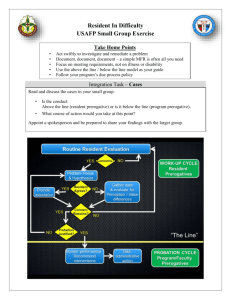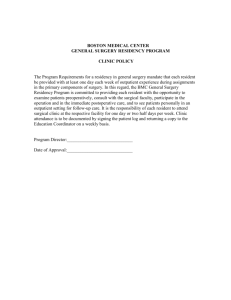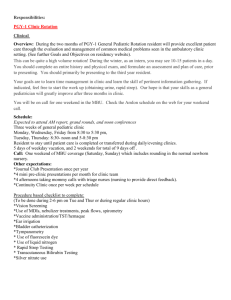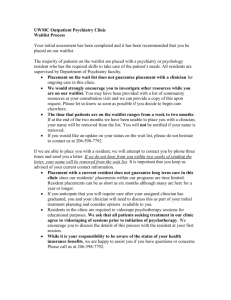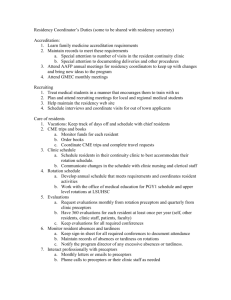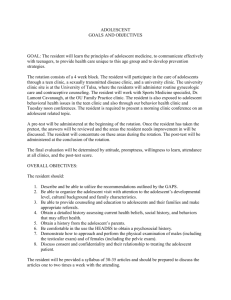table of contents - UBC Pediatrics Residency Program
advertisement
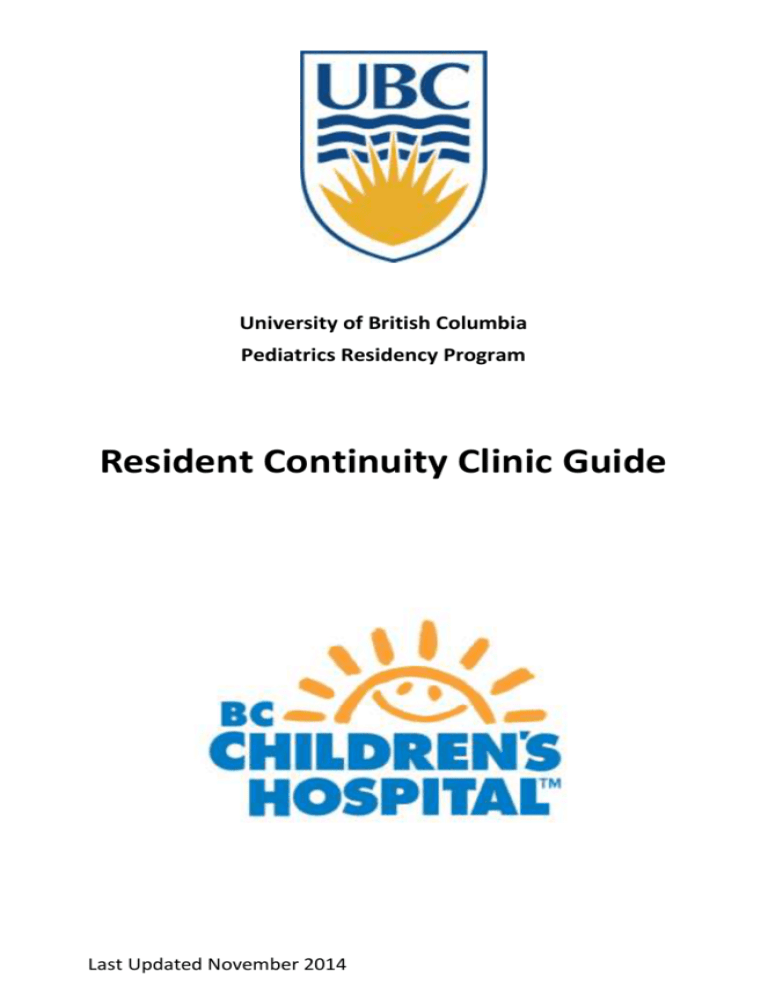
University of British Columbia Pediatrics Residency Program Resident Continuity Clinic Guide Last Updated November 2014 -1- TABLE OF CONTENTS TABLE OF CONTENTS........................................................ - 2 INTRODUCTION ............................................................... - 4 OBJECTIVES ..................................................................... - 4 GROUP PRACTICE ............................................................ - 5 RESIDENT GROUPS......................................................................... - 5 LOCATION ...................................................................................... - 5 TIMING........................................................................................... - 5 RCC SCHEDULE ............................................................................... - 6 MEDICAL STUDENT ........................................................................ - 6 - PATIENTS ......................................................................... - 7 PATIENT POPULATION ................................................................... - 7 RECRUITING ................................................................................... - 8 DURATION OF FOLLOW UP ............................................................ - 8 - LOGISTICS ...................................................................... - 10 CHARTING .................................................................................... - 10 TEST RESULTS............................................................................... - 10 ACCESSING OUTSIDE LAB RESULTS.............................................. - 11 PHONE TRIAGE............................................................................. - 13 PATIENT SCHEDULING ................................................................. - 13 - HANDOVER.................................................................... - 15 PATIENT DATABASE ..................................................................... - 15 DIRECT PHONE OR EMAIL HANDOVER ........................................ - 15 - SUPERVISION AND EVALUATION .................................... - 17 ADMINISTRATIVE SUPPORT ........................................... - 18 - -2- RCC ETIQUETTE .............................................................. - 19 Teamwork .................................................................................... - 19 Communication ........................................................................... - 19 Planning ....................................................................................... - 19 Follow up ..................................................................................... - 20 Professionalism............................................................................ - 20 - FAQs.............................................................................. - 21 USEFUL JARGON ............................................................ - 25 RESIDENT TEAM LIST...................................................... - 26 CONTACT INFORMATION ............................................... - 27 Administrative Support................................................................ - 27 Supervising Staff .......................................................................... - 27 Clinic Director .............................................................................. - 27 RCC Committee............................................................................ - 27 - -3- INTRODUCTION As pediatrics residents, we are exposed to the majority of our patients briefly, usually during a hospitalization or single clinic visit. We are thus very well-trained in managing acute pediatric issues, but were lacking the continuity of care that would help us learn the management of chronic pediatric conditions and follow a child through normal growth and development. Participating in a resident continuity clinic in a longitudinal fashion during our core pediatrics years will fill this gap in our training and help us better transition into our future practices as general pediatricians and pediatrics specialists. OBJECTIVES In the resident continuity clinic, we will: - See new general pediatrics patients referred from the ER, any subspecialty clinic or from community GPs - Follow patients we have managed while on CTU, in the ER or in the intermediate nursery in the outpatient setting - Take ownership of our patients and our clinic by seeing patients independently, selecting and requesting investigations, following up on results, and arranging consultations -4- GROUP PRACTICE Starting January, R1s are involved as regular doctors in the clinic. R4s are phased out in January, but will help out when staffing is an issue. RESIDENT GROUPS There are 4 resident teams, each consisting of 10-12 residents. These teams will function as group practices, much like Pediatricians in the community. Each team will be responsible for 1 clinic afternoon (Monday, Wednesday, Thursday and Friday). These teams were formed to ensure that a minimum of 2 residents, and a maximum of 3, will be available per clinic afternoon. LOCATION The resident clinic will take place in Area 7 of the Ambulatory Care Building where the current General Pediatrics Clinic is located. You can reach this clinic at local 2130. TIMING Each resident is scheduled for one afternoon clinic (12:455pm), approximately every 2 weeks, during rotations that allow for RCC protected time off. Note that the first 15 minutes prior to clinic start are dedicated to CPS statement review. Residents are responsible for referring to the RCC schedules that are routinely sent out to find out what dates the resident is expected in clinic. -5- Efforts will be made to schedule you every 2 weeks in RCC unless: You are on vacation You are on an away rotation, an off-site rotation (that is far from BCCH) You are on an elective rotation You are on CTU or Night Float You are post-call MEDICAL STUDENT In the morning medical students have full autonomy to see patients on their own but afternoon clinics are reserved for RCC; where residents have their own patients booked. Students are advised to tag along with one resident, where the resident might give them an opportunity to do a part of history or examine a system. Even if none is done, they (students) can learn from residents on how to take an organized history, interacting with parents, examining child etc. Also, unless the clinic is very busy, residents should see all patients and avoid having MSI see patients on their own. The main reason is supervision of an MSI is different from supervising a resident. Pediatricians have to spend more time to review with a student. RCC SCHEDULE The RCC Committee will periodically issue a RCC Schedule for residents (2-3 residents per clinic afternoon). This often comes out many months ahead of time. Once the draft is out, it is the resident’s responsibility to identify scheduling conflicts (eg -6- scheduled for clinic during vacation / conference leave, etc.) and notify the RCC Committee so we can make appropriate changes. Once the final schedule is out, any conflicts identified will have to be dealt with by the resident themselves. Typically, this involves trading shifts with another resident, ideally from the resident’s own group, or from another group if no one is available. Once a switch is made, 3 people need to be notified: Charlett, your attending and the RCC Committee scheduling person. An up to date RCC schedule will be posted in Clinic, on the notice board in the Resident Lounge and on the Resident Website. PATIENTS PATIENT POPULATION Patients will either be referred to the Resident Continuity Clinic or be recruited by the residents themselves. Here are a few examples of where patients come from: ° Referrals from the BCCH Emergency Department, Pediatric Subspecialty Clinics, or community GPs ° Patients who have been admitted to the Clinical Teaching Unit (CTU), Intermediate Nursery (IN) who live in Vancouver and who do not already have a pediatrician can be recruited. -7- ° Patients referred to a pediatric subspecialty clinic who are deemed by the subspecialist to have a condition that can be appropriately assessed and managed by a general pediatrician RECRUITING Residents must take initiative to recruit their own patients. This is the best way to ensure that the continuity clinic experience is as valuable as possible. There are pamphlets available on the 3M (grey filing cabinet behind the unit clerk) as well as in the clinic space (near Charlett’s computer). Every resident should also have their own personalized business cards which can be distributed per resident’s discretion. You can carry your own stash, and there is also a Roladex near the Blue computer on 3M and by Charlett’s computer in the clinic. Residents need to make sure there is always a supply of their cards in each Roladex so that anyone can hand them out on the resident’s behalf. DURATION OF FOLLOW UP This will be decided on a case by case basis. Ideally, patients will be followed for the duration of the resident's core pediatrics training. However, a patient who is being followed for a particular issue which has been dealt with may be discharged from the clinic if deemed appropriate by the resident and supervising pediatrician. An example of this is a child who was being followed up shortly after an admission for bronchiolitis and is doing well, or an infant with a first -8- febrile urinary tract infection who is well and all follow up investigations are normal. Children who are discharged from the clinic should have further follow up with their primary care physician. Patients who still need follow up after a resident is finished their core pediatrics training should be transferred to another (more junior) resident. Ensuring adequate follow up is the responsibility of the resident who has taken charge of those particular patients. -9- LOGISTICS CHARTING Hospital charts will be available at each visit and should be updated appropriately including documentation of the encounter as well as a dictated summary of every clinic visit. In addition, the patient’s chart will have a growth chart which requires regular updating. An excel spreadsheet is available on the RCC computer desktop. Log in as 3HResident (Password 3h3h3h) and a shortcut to RCC Patient Database is on the desktop. Choose the sheet corresponding to your clinic day, and please log all relevant patient information. This serves both as a patient log and as an up to date “to do list” to which your colleagues can refer when they are seeing your patients on your behalf. TEST RESULTS All test results and consultation reports will be sent to the attending staff. The resident will follow up themselves on all investigations that have been ordered. The resident must communicate by email/phone with their attending to confirm that they have reviewed the results and notify them of what actions have been taken. Residents will also be responsible for communicating results to families when necessary. Bloodwork and imaging done in hospital will be accessible on eChart or EVE or iStentor. If outside lab, done either at - 10 - LifeLabs or BC Biomedical, the results can be accessed through eChart (eHealth Viewer). Most consultations done at BCCH will be available through EVE. For those consults that are not posted to EVE (Genetics, CPS, etc.) or outside consultations (Psychoeducational assessments, Sunny Hill Assessments, etc.) will be filed in a folder next to Charlett’s desk. You will be responsible for checking this folder on a regular basis if you are expecting a report. ACCESSING OUTSIDE LAB RESULTS ° ° Open your patient list in PowerChart Click on eHeath Viewer ° Enter Patient’s PHN as directed - 11 - ° Access Labs by clicking on “Labs (PLIS)” - 12 - PHONE TRIAGE The families and patients will be able to call the clinic between visits and leave a message for a particular resident. That resident will be notified when someone calls and is expected to answer the phone calls from a family/patient within 24 hours. These phone conversations should be documented in the chart of the patient and should also be discussed with the preceptor. Currently, if the resident is on vacation / conference / away on elective, and is unable to respond to the call, the message will default to the RCC MRP. We are working on implementing a system that would keep resident in the loop and responsible for their own patients. When the calls are received by Charlett, she will either email you (for non-urgent issues) or page you (for more urgent issues.) PATIENT SCHEDULING To book an appointment in the clinic, please call the ACB Area 7 (ext 2130) and book directly with Charlett. New consults received from the ER or community physicians will be booked into empty clinic slots. New consults will be booked for 1 hour slots and follow ups will be 30 minutes. You can view the schedule ahead of time through PowerChart to find out which patient you and your team are expected to see. To avoid keeping patients who are new to you waiting, we suggest you review the patient’s chart before coming to the clinic. - 13 - - 14 - HANDOVER PATIENT DATABASE We are using an Excel Spreadsheet with 4 Sheets, one for each group, to keep track of patients. The document serves both as a database to easily identify the Most Responsible Resident (MRR) for any given patient, as well as serving as a handover tool. This document must be updated at the end of each clinic day by the resident. It contains a list of items that must be followed up prior to next patient visit as well as a “to do/address/re-assess” list for the next planned visit. This is a safety in case the MRR will not be the one seeing the patient at the next visit due to unforeseen circumstances (and no formal email handover took place). The database can be accessed on any computed by using the 3HResidents Login and finding the document on the U:/ drive. DIRECT PHONE OR EMAIL HANDOVER If a resident cannot attend his/her clinic because of an emergency and a patient cannot be rescheduled, then the resident must ensure that the patient is seen by another member of their team. Or, if a patient requires follow-up sooner than the resident is scheduled for their next clinic, then another member of the team should follow this patient and liaise with the most responsible resident. In this situation, proper verbal or emailed handover should take place between the primary resident (MRR) and the covering resident to ensure efficiency of the clinic and good continuity of patient - 15 - care. - 16 - SUPERVISION AND EVALUATION Each resident will be assigned to a certain staff pediatrician. Currently, Dr. Virji supervises on Mondays, Wednesdays and Friday afternoons, occasionally replaced by Dr. Smith. Dr. Greenmand covers Thursday afternoons. Although the resident is responsible for following up all tests and consults and for communication with families, the Attending Pediatrician is ultimately responsible for patient care. It is very important that residents communicate with attendings when interpreting results and making recommendations outside of clinic hours. This is best done by email. They also act as role model for the residents. They must review and sign the patients’ charts at the end of each clinic and be available to the resident by phone or email when necessary. Verbal feedback should be given to the resident at the end of each clinic. A One45 evaluation will be filled out for each resident once every four months. Similarly, the resident will be asked to fill out One45 evaluations of staff and clinic itself on a regular basis. Residents will also be solicited for anonymous feedback by the RCC Committee as this is a resident driven initiative and improvements need to be identified and driven by residents. Dr. Janet Greenman is the RCC Director and will oversee all RCC related matters and help guide this clinic as it expands to meet the community’s needs and our educational requirements. - 17 - ADMINISTRATIVE SUPPORT The clinic has its own administrative support as well as its own telephone number available to the patients (Charlett McClay, ext 2130). She will be responsible for the scheduling and confirmation of patient visits, preparation of charts, retrieval and sorting of test results and scheduling of special tests. She will also answer clinic calls and communicate messages to the appropriate residents between 8am and 4pm from Monday to Friday. - 18 - RCC ETIQUETTE Teamwork ° ° If a colleague doesn’t show, please page/text them If you see a patient on behalf of your colleague, please refer them back. They should do the same when seeing one of your patients on your behalf. Communication ° ° Keep Patient database up to date Email or phone communication in advance if you plan on having someone else see one of your patients on your behalf. Email or phone MRR with updates about the patient you saw on their behalf. Planning ° ° ° Divide up patients at the start of clinic so workload is balanced and you can get out on time for afternoon rounds. If there is a long wait time before your first patient, see if you can help out by seeing Gen Peds patients (i.e. not assigned to RCC- so long as also not assigned to MSI), or make use of your time by reading. Allow 1h for new patients and 30 minutes for followup visits. - 19 - Follow up ° ° ° Outside labs and imaging now available through eHealth Viewer/PowerChart Consults that cannot be found on EVE will be filed next to Charlett and available for our viewing. Please stay on top of your consults and results. Professionalism ° ° ° ° Arrive on time; if you must deal with a ward emergency, you must call the clinic and let Charlett/ your attending know. As soon as RCC schedule is out, look for any vacation/conference/call conflicts Remind your rotation coordinator, ahead of the start of the rotation, of your RCC clinic dates and ask not to be post-call on those days. Should you have an unexpected conflict, you must find someone to replace you (keep us in the loop). If you are really in a bind, Charlett can schedule fewer patients on that day if there is enough notice - 20 - FAQs What if a patient needs medical care in between clinic visits? Between 08:00 and 16:00, families can call the clinic and speak to Charlett who will notify the resident by pager (or email if it is not urgent). If they need immediate attention, the patient will be referred to the ER. The resident should call the ER and advise them that the patient is on their way. If they do not need emergency attention, the resident can book the patient to be seen at the clinic at the soonest appropriate time. These phone assessments should all be reviewed with the supervising staff. Outside of working hours: the patient should be taken to the emergency room in case of emergency. In non-emergent situations, the family can call on the next working day. The resident is to be contacted if one of his/her patients presents is admitted to the hospital and should be able to participate in the care of his/her patient, along with the treating team. - 21 - Am I expected to go to clinic while on PICU, NICU and Oncology wards? Yes, all departments are aware the Resident Continuity Clinic is protected time from 12:45-17:00 for pediatrics residents. However, YOU will be responsible to alerting them to your specific clinic day as this is variable between residents. For now, the only in-hospital rotation during which you will not be expected to go to clinic is CTU and Night float. This may change in the future depending on feedback that residents give us. What if I want to book a patient in on a different day than the one that is assigned to me? Try to avoid doing this. You can follow up your patients on your clinic day or on the alternate week. As there is limited physical space in the clinic. You can also book your patient in to see another resident as long as it is OK with Charlett (ext 2130) and the other resident. What if I am discharging a patient from CTU and want to follow them in clinic shortly after? That’s perfect! You are encouraged to see patients even while you are on CTU (it’s just not mandatory). Make sure with Charlett (ext 2130) that there is room on your team’s clinic day and make sure that you are available as well. - 22 - There are RCC business cards available in the Roladex next to the CTU Blue computer on which you can write your name and the date and time of your patient’s appointment. Brochures about the clinic will also be available shortly. What if Charlett pages me or emails me when I am away on vacation or post-call? If she pages you for an urgent matter and you do not respond in a timely manner, Charlett will always have the option of paging the attending staff involved with that patient. How do I document phone conversations or any important communications in the chart? In the same way that you always do it...you need to write a note on a history sheet and have it put into the clinic chart. You can even just type/write up a quick note about your conversation with the patient’s name, date, etc. on it and give it to Charlett to be filed in the chart. How many patients will we be seeing per clinic? Generally, you should be seeing 1-4 patients per clinic, depending on how many other residents there are in clinic at the same time. Initially, you may only be seeing 1 new patient per clinic. That way you can “build up your practice” from scratch! You may also be seeing follow-up patients who were formerly followed by the General Pediatrics Clinic and who are appropriate for the RCC. - 23 - Will I be in clinic for the whole afternoon? Yes, you are expected to be at the clinic by 12:45 with your colleagues. You will be responsible for seeing your own patients and patients new to RCC will be divided amongst your group members. - 24 - USEFUL JARGON RCC: Resident Continuity Clinic MRR: Most Responsible Resident- Usually refers to the first resident who saw the patient or did the initial consult. Otherwise, it is simply the resident who has the most continuity with the patient. MRP: Most responsible Physician- One of the RCC Pediatricians (Attendings) who is ultimately (and medicolegally) responsible for the care of the patient and supervision of the resident caring for that patient. - 25 - RESIDENT TEAM LIST Group 1 Monday Group 2 Wednesday Kamal Abdulwahab (R3) Alison Nutter (R3) Michelle Sherwood (R3) Arash Adjudani (R2) Henry Stringer (R2) Elizabeth deKlerk (R1) Michelle Lai (R1) Juliana Wu (R1) Matthew Carwana (R1) Samara Laskin (R1) Melanie Finkbeiner (R3) Lanna Olson (R3) Lana Shaiba (R3) Trisha Patel (R2) Alison Lee (R2) Candace Creighton (R1) Vickie Chow (R1) Kristen Favel (R1) Jennifer Cutting (R1) Rebecca Ronsley (R1) Group 3 Thursday Group 4 Friday Stephany Quinn (R3) Jessica Breton (R3) Anas Manouzi (R3) Mike Fazio (R2) Anamaria Richardson (R2) Carmen Tait (R2) Isaac Elias (R2) Rachel Li (R2) Faith Cormier (R1) Keira Dheensaw (R1) Colin Meyer-MacAuley (R3) Alysha Dedhar (R3) Victoria Cook (R3) Meghan Gilley (R3) Irvin Janjua (R3) Megan Kilvert (R2) Caroline Malcolmson (R2) Steven Rathgeber (R2) Charmaine Wong (R2) Jennifer Sibley (R1) Sofie Lopez (R1) - 26 - CONTACT INFORMATION Administrative Support Charlett McClay cmcclay@cw.bc.ca Supervising Staff Dr. J. Greenman Dr. M. Virji janet.greenman@cw.bc.ca mvirji2@cw.bc.ca Clinic Director Dr. J. Greenman janet.greenman@cw.bc.ca RCC Committee R1 – R1 – Elizabeth.DeKlerk@cw.bc.ca Jennifer.Cutting@cw.bc.ca R2 – Mike Fazio R3 – Jessica Breton mike.fazio@cw.bc.ca Jessica.breton@cw.bc.ca - 27 - Please do not hesitate to contact us for any concerns, comments, suggestions that you may have for the clinic. This is a work in progress and we would appreciate any feedback! -RCC Committee Last Updated January 2014 Delete this Textbox prior to Printing! For best printing, in booklet format: Print from PC 1 page per sheet (document is already set up to print 2 pages per sheet) Two sided printing, flip on short edge - 28 -
